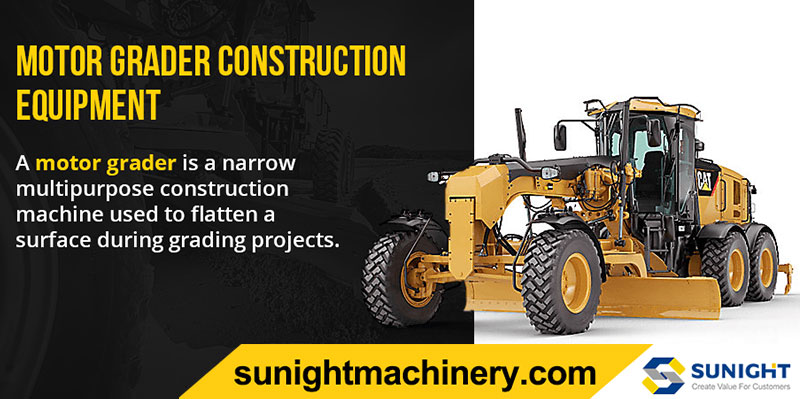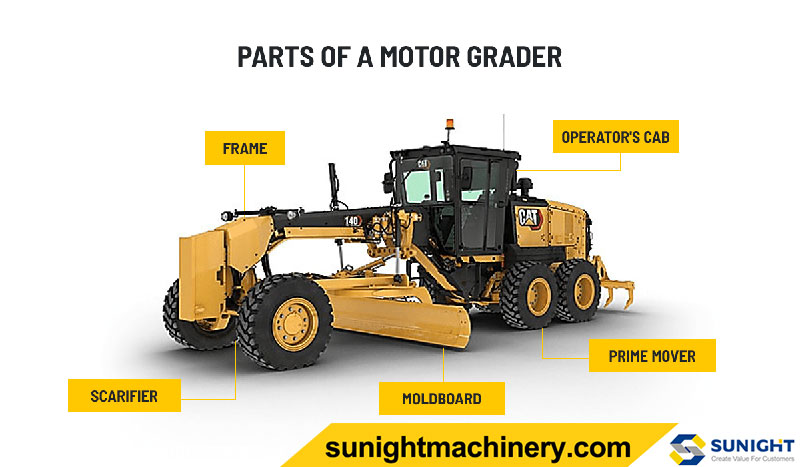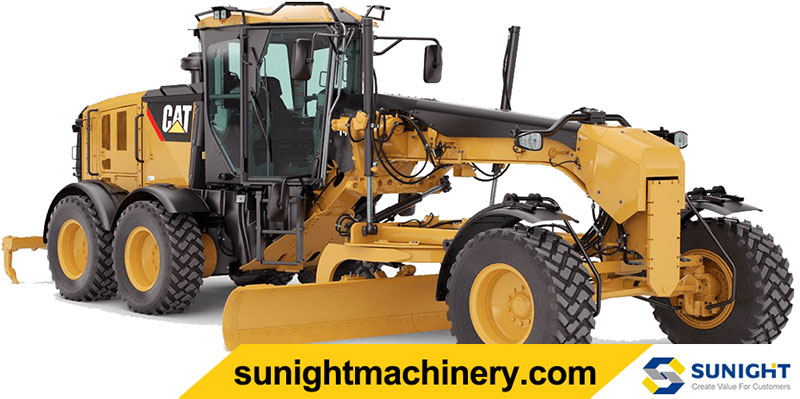A motor grader is a construction vehicle used to maintain unpaved roads and establish the final grades on construction projects. They are designed to create flat surfaces and can spread dirt and remove debris. They are best recognized for their long adjustable blade.
Motor grades are also suitable for different applications, which can be accomplished by attaching particular units on the machinery. There are two types of motor graders, depending on the arrangement of the frame. The rigid frame type has a single axle and cannot turn in both directions about a point while the articulated frame type has a hinge between the two axles. The feature of the latter makes it suitable for turning around in small spaces.
The grader, also known as motor grader or road grader, is described as heavy-duty machine designed with a long blade that is used in different industry sectors. Graders are most commonly used in civil construction, roadworks and on mining sites for creating smooth and flat surfaces. Certain graders can operate multiple attachments, or be designed for specialized tasks like underground mining. In civil engineering, the grader's purpose is to "finish grade" (to refine or set precisely).
Graders are commonly used in the construction and maintenance of dirt and gravel roads for creating a flat surface where the asphalt will be placed. For civil engineering projects, the purpose of the graders is to perform fine grading.
The motor grader can also be found on major mining sites all over the world. An extremely versatile machine, grader operators are needed for a wide variety of construction, roadworks and mining tasks.
Primarily, motor graders are designed to scrape and shift flat or angled substrate in order to form smooth, level surfaces. Sometimes, they’re used to shift soil and earth into precise mounds. The blade on a motor grader can be used on construction sites, road works and farms. Here are some of the jobs it can do:
build gravel or dirt roads and tracks
grade gravel roads to eliminate rutting and potholes
general ground levelling
create and level embankments next to roads and fields
shape canal banks
smooth the gravel underlay of new tar roads
create and grade haul roads for mines
form windrows, turnrows and drainage ditches on farms
terrace sloped gardens and farms
clear snow and slush from roads in cold areas.
In the early days, dozers were most commonly used for grading. However, with the need for improved quality of surface finish and speeding up the grading process, motor graders were introduced solely for grading purposes. Since then, their demand has picked up like anything.
Motor graders or alternatively called road graders or graders are absolutely necessary equipment at any construction site. They are usually self-propelled machines with an adjustable blade. Typical motor grader models have three axles with the engine and cab situated above the rear axles at one end of the vehicle and a third axle at the front end of the vehicle with the blade in between.
Motor graders are generally identified by their long adjustable blade and considered to be easy-to-use equipment for mining underneath the ground. Another factor that differentiates motor graders is the drive systems with some of the equipment using all wheel drive i.e., four wheel drive and front wheel drive systems. For rural areas with unpaved roads, an all wheel drive system is necessary while it is redundant for smooth and clear areas.
Motor graders are generally classified into two categories based on the structure and arrangement of the frame i.e., Rigid Frame Motor Grader and Articulated Frame Motor Grader. Of the two, the later is the most commonly used version these days.
In simple terms, motor graders are used to finish grade (refine, set precisely) the rough grading performed by heavy CE such as scrapers and bulldozers. A small motor grader within a range of 80-150 horsepower is usually enough for most jobs. While, the smaller graders are perfect for jobs that need to be completed in a tight spacing environment, larger motor graders can be used in broader spaces. Larger machines are known to use a direct drive or a torque converter drive transmission system while the smaller ones are hydrostatically driven.
A motor grader, sometimes called a grader or road grader, is a narrow multipurpose construction machine used to flatten a surface during grading projects. Generally speaking, the working principle of a motor grader machine is it uses its moldboard, or blade, for rough or fine grading. However, the moldboard’s position and pitch can be hydraulically manipulated to complete a variety of tasks.
When a project calls for fine grading, you’ll want to consider using a motor grader. Motor graders also make excellent snow removal machines. Many business owners value their motor graders above other equipment. According to a survey, almost 88 percent of the surveyed engineers and equipment operations managers called their grader their most important piece of equipment. Many industry professionals favor graders because they keep the roads in shape and are great tools for big projects.
A motor grader is a large piece of equipment with a unique shape. Here are some of its main components:
Motor graders play an essential role in performing accurate grading and leveling. To demonstrate the importance of accuracy when it comes to roadbuilding, consider the different layers a piece of grader equipment must work with. A road consists of three layers – the surface, the base, and the subgrade. The surface may be asphalt, gravel or another material. It must provide a good surface for driving and be resistant to wear, skids and water. The base and subbase layers provide strength for the pavement surface. The base consists of compacted gravel, sand, rock, or a mix of these materials. The subgrade is the existing natural soil.
Before road construction can occur, the top 12 or 24 inches of the ground must be prepared by removing rocks, stumps, brush, and other materials. Proper drainage is also needed to keep a stable base. The right road grading equipment, like a motor grader, can accomplish all of the essential tasks in roadbuilding from start to finish, ensuring solid, long-lasting roads.
Overall, motor graders are versatile, powerful machines suitable for large projects. They may be used to complete any of the following tasks: